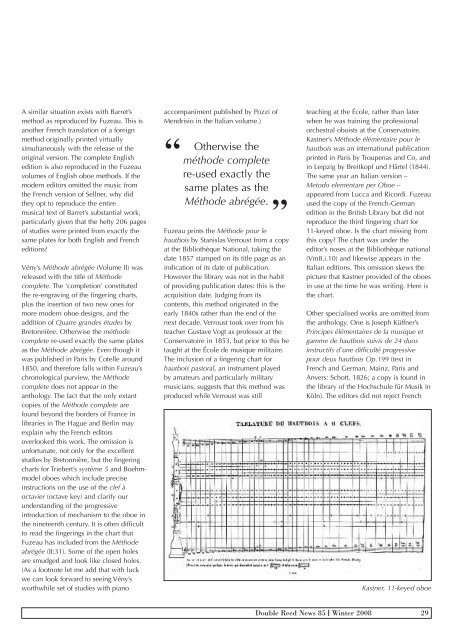Double Reed 70 cover - British Double Reed Society
Double Reed 70 cover - British Double Reed Society
Double Reed 70 cover - British Double Reed Society
You also want an ePaper? Increase the reach of your titles
YUMPU automatically turns print PDFs into web optimized ePapers that Google loves.
A similar situation exists with Barret’s<br />
method as reproduced by Fuzeau. This is<br />
another French translation of a foreign<br />
method originally printed virtually<br />
simultaneously with the release of the<br />
original version. The complete English<br />
edition is also reproduced in the Fuzeau<br />
volumes of English oboe methods. If the<br />
modern editors omitted the music from<br />
the French version of Sellner, why did<br />
they opt to reproduce the entire<br />
musical text of Barret’s substantial work,<br />
particularly given that the hefty 206 pages<br />
of studies were printed from exactly the<br />
same plates for both English and French<br />
editions?<br />
Vény’s Méthode abrégée (Volume II) was<br />
released with the title of Méthode<br />
complete. The ‘completion’ constituted<br />
the re-engraving of the fingering charts,<br />
plus the insertion of two new ones for<br />
more modern oboe designs, and the<br />
addition of Quatre grandes études by<br />
Bretonnière. Otherwise the méthode<br />
complete re-used exactly the same plates<br />
as the Méthode abrégée. Even though it<br />
was published in Paris by Cotelle around<br />
1850, and therefore falls within Fuzeau’s<br />
chronological purview, the Méthode<br />
complete does not appear in the<br />
anthology. The fact that the only extant<br />
copies of the Méthode complete are<br />
found beyond the borders of France in<br />
libraries in The Hague and Berlin may<br />
explain why the French editors<br />
overlooked this work. The omission is<br />
unfortunate, not only for the excellent<br />
studies by Bretonnière, but the fingering<br />
charts for Triebert’s système 5 and Boehmmodel<br />
oboes which include precise<br />
instructions on the use of the clef à<br />
octavier (octave key) and clarify our<br />
understanding of the progressive<br />
introduction of mechanism to the oboe in<br />
the nineteenth century. It is often difficult<br />
to read the fingerings in the chart that<br />
Fuzeau has included from the Méthode<br />
abrégée (II:31). Some of the open holes<br />
are smudged and look like closed holes.<br />
(As a footnote let me add that with luck<br />
we can look forward to seeing Vény’s<br />
worthwhile set of studies with piano<br />
accompaniment published by Pozzi of<br />
Mendrisio in the Italian volume.)<br />
“ Otherwise the<br />
méthode complete<br />
re-used exactly the<br />
same plates as the<br />
Méthode abrégée.<br />
”<br />
Fuzeau prints the Méthode pour le<br />
hautbois by Stanislas Verroust from a copy<br />
at the Bibliothèque National, taking the<br />
date 1857 stamped on its title page as an<br />
indication of its date of publication.<br />
However the library was not in the habit<br />
of providing publication dates: this is the<br />
acquisition date. Judging from its<br />
contents, this method originated in the<br />
early 1840s rather than the end of the<br />
next decade. Verroust took over from his<br />
teacher Gustave Vogt as professor at the<br />
Conservatoire in 1853, but prior to this he<br />
taught at the École de musique militaire.<br />
The inclusion of a fingering chart for<br />
hautbois pastoral, an instrument played<br />
by amateurs and particularly military<br />
musicians, suggests that this method was<br />
produced while Verroust was still<br />
teaching at the École, rather than later<br />
when he was training the professional<br />
orchestral oboists at the Conservatoire.<br />
Kastner’s Méthode élémentaire pour le<br />
hautbois was an international publication<br />
printed in Paris by Troupenas and Co, and<br />
in Leipzig by Breitkopf und Härtel (1844).<br />
The same year an Italian version –<br />
Metodo elementare per Oboe –<br />
appeared from Lucca and Ricordi. Fuzeau<br />
used the copy of the French-German<br />
edition in the <strong>British</strong> Library but did not<br />
reproduce the third fingering chart for<br />
11-keyed oboe. Is the chart missing from<br />
this copy? The chart was under the<br />
editor’s noses at the Bibliothèque national<br />
(Vm8.i.10) and likewise appears in the<br />
Italian editions. This omission skews the<br />
picture that Kastner provided of the oboes<br />
in use at the time he was writing. Here is<br />
the chart.<br />
Other specialised works are omitted from<br />
the anthology. One is Joseph Küffner’s<br />
Principes élémentaires de la musique et<br />
gamme de hautbois suivis de 24 duos<br />
instructifs d’une difficulté progressive<br />
pour deux hautbois Op.199 (text in<br />
French and German, Mainz, Paris and<br />
Anvers: Schott, 1826; a copy is found in<br />
the library of the Hochschule für Musik in<br />
Köln). The editors did not reject French<br />
Kastner, 11-keyed oboe<br />
<strong>Double</strong> <strong>Reed</strong> News 85 Winter 2008 29


